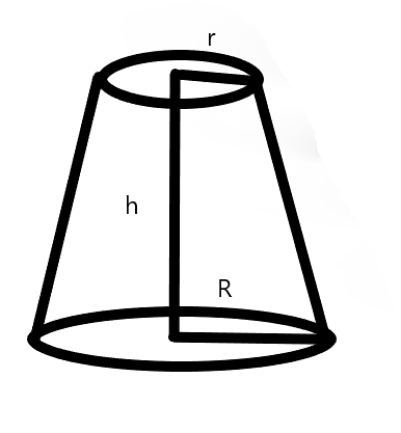Answer
396k+ views
Hint: As we know that the area of circle is given as \[{\text{$\pi$ }}{{\text{r}}^{\text{2}}}\]. From this calculate the radius of both base and upper circle. And then apply the formula of volume of frustum which is \[{\text{v = }}\dfrac{{{\text{$\pi$ h}}}}{{\text{3}}}{\text{(}}{{\text{R}}^{\text{2}}}{\text{ + Rr + }}{{\text{r}}^{\text{2}}}{\text{)}}\]. And thus from all these we can easily calculate the height of the frustum of cone.
Complete step by step answer:
Diagram:

Let R and r be the radius of upper and base circle. As the base and the upper area of the circle is \[{\text{16m}}{{\text{m}}^2}\]and \[{\text{100m}}{{\text{m}}^2}\].
\[
{\text{for ,A = $\pi$ }}{{\text{R}}^{\text{2}}}{\text{ = 100}} \\
\Rightarrow {{\text{R}}^{\text{2}}}{\text{ = }}\dfrac{{{\text{100}}}}{{\text{$\pi$ }}} \\
{\text{On taking root we get,}} \\
\Rightarrow {\text{R = }}\dfrac{{{\text{10}}}}{{\sqrt {\text{$\pi$ }} }} \\
{\text{for,A = $\pi$ }}{{\text{r}}^{\text{2}}}{\text{ = 16}} \\
\Rightarrow {{\text{r}}^{\text{2}}}{\text{ = }}\dfrac{{{\text{16}}}}{{\text{$\pi$ }}} \\
{\text{On taking root we get,}} \\
\Rightarrow {\text{r = }}\dfrac{{\text{4}}}{{\sqrt {\text{$\pi$ }} }} \\
\]
Now, put the value of volume given and both the radii in the formula of volume of frustum, we get
\[{\text{v = }}\dfrac{{{\text{$\pi$ h}}}}{{\text{3}}}{\text{(}}{{\text{R}}^{\text{2}}}{\text{ + Rr + }}{{\text{r}}^{\text{2}}}{\text{)}}\]
\[
\Rightarrow {\text{v = }}\dfrac{{{\text{$\pi$ h}}}}{{\text{3}}}{\text{(}}\dfrac{{{\text{100}}}}{{\text{$\pi$ }}}{\text{ + (}}\dfrac{{{\text{10}}}}{{\sqrt {\text{$\pi$ }} }}{\text{)(}}\dfrac{{\text{4}}}{{\sqrt {\text{$\pi$ }} }}{\text{) + }}\dfrac{{{\text{16}}}}{{\text{$\pi$ }}}{\text{)}} \\
\Rightarrow {\text{1600 = }}\dfrac{{{\text{$\pi$ h}}}}{{\text{3}}}{\text{(}}\dfrac{{{\text{156}}}}{{\text{$\pi$ }}}{\text{)}} \\
\Rightarrow {\text{52h = 1600}} \\
\Rightarrow {\text{h = }}\dfrac{{{\text{1600}}}}{{{\text{52}}}} \\
\Rightarrow {\text{h = 30}}{\text{.76mm}} \\
\]
Hence, option (a) is our correct answer.
Note: In geometry, a frustum is a portion of a solid (normally a cone ) that lies between one or two parallel planes cutting it. A right frustum is a parallel truncation of a right pyramid or right cone.
The formula to calculate the volume of the frustum is basically the volume of the big cone minus the volume of the small cone which is cut off.
The formula of volume of frustum which is \[{\text{v = }}\dfrac{{{\text{$\pi$ h}}}}{{\text{3}}}{\text{(}}{{\text{R}}^{\text{2}}}{\text{ + Rr + }}{{\text{r}}^{\text{2}}}{\text{)}}\].
Complete step by step answer:
Diagram:

Let R and r be the radius of upper and base circle. As the base and the upper area of the circle is \[{\text{16m}}{{\text{m}}^2}\]and \[{\text{100m}}{{\text{m}}^2}\].
\[
{\text{for ,A = $\pi$ }}{{\text{R}}^{\text{2}}}{\text{ = 100}} \\
\Rightarrow {{\text{R}}^{\text{2}}}{\text{ = }}\dfrac{{{\text{100}}}}{{\text{$\pi$ }}} \\
{\text{On taking root we get,}} \\
\Rightarrow {\text{R = }}\dfrac{{{\text{10}}}}{{\sqrt {\text{$\pi$ }} }} \\
{\text{for,A = $\pi$ }}{{\text{r}}^{\text{2}}}{\text{ = 16}} \\
\Rightarrow {{\text{r}}^{\text{2}}}{\text{ = }}\dfrac{{{\text{16}}}}{{\text{$\pi$ }}} \\
{\text{On taking root we get,}} \\
\Rightarrow {\text{r = }}\dfrac{{\text{4}}}{{\sqrt {\text{$\pi$ }} }} \\
\]
Now, put the value of volume given and both the radii in the formula of volume of frustum, we get
\[{\text{v = }}\dfrac{{{\text{$\pi$ h}}}}{{\text{3}}}{\text{(}}{{\text{R}}^{\text{2}}}{\text{ + Rr + }}{{\text{r}}^{\text{2}}}{\text{)}}\]
\[
\Rightarrow {\text{v = }}\dfrac{{{\text{$\pi$ h}}}}{{\text{3}}}{\text{(}}\dfrac{{{\text{100}}}}{{\text{$\pi$ }}}{\text{ + (}}\dfrac{{{\text{10}}}}{{\sqrt {\text{$\pi$ }} }}{\text{)(}}\dfrac{{\text{4}}}{{\sqrt {\text{$\pi$ }} }}{\text{) + }}\dfrac{{{\text{16}}}}{{\text{$\pi$ }}}{\text{)}} \\
\Rightarrow {\text{1600 = }}\dfrac{{{\text{$\pi$ h}}}}{{\text{3}}}{\text{(}}\dfrac{{{\text{156}}}}{{\text{$\pi$ }}}{\text{)}} \\
\Rightarrow {\text{52h = 1600}} \\
\Rightarrow {\text{h = }}\dfrac{{{\text{1600}}}}{{{\text{52}}}} \\
\Rightarrow {\text{h = 30}}{\text{.76mm}} \\
\]
Hence, option (a) is our correct answer.
Note: In geometry, a frustum is a portion of a solid (normally a cone ) that lies between one or two parallel planes cutting it. A right frustum is a parallel truncation of a right pyramid or right cone.
The formula to calculate the volume of the frustum is basically the volume of the big cone minus the volume of the small cone which is cut off.
The formula of volume of frustum which is \[{\text{v = }}\dfrac{{{\text{$\pi$ h}}}}{{\text{3}}}{\text{(}}{{\text{R}}^{\text{2}}}{\text{ + Rr + }}{{\text{r}}^{\text{2}}}{\text{)}}\].
Recently Updated Pages
The branch of science which deals with nature and natural class 10 physics CBSE

The Equation xxx + 2 is Satisfied when x is Equal to Class 10 Maths

Define absolute refractive index of a medium

Find out what do the algal bloom and redtides sign class 10 biology CBSE

Prove that the function fleft x right xn is continuous class 12 maths CBSE

Find the values of other five trigonometric functions class 10 maths CBSE

Trending doubts
Difference Between Plant Cell and Animal Cell

Difference between Prokaryotic cell and Eukaryotic class 11 biology CBSE

Fill the blanks with the suitable prepositions 1 The class 9 english CBSE

Change the following sentences into negative and interrogative class 10 english CBSE

Summary of the poem Where the Mind is Without Fear class 8 english CBSE

Give 10 examples for herbs , shrubs , climbers , creepers

Write an application to the principal requesting five class 10 english CBSE

What organs are located on the left side of your body class 11 biology CBSE

What is the z value for a 90 95 and 99 percent confidence class 11 maths CBSE



